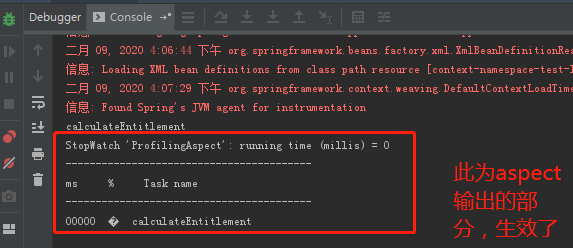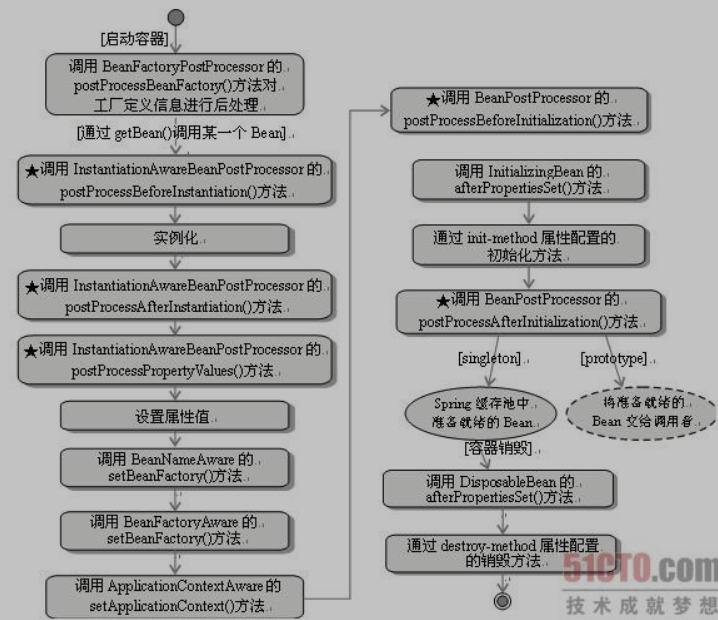曹工说Spring Boot源码(15)-- Spring从xml文件里到底得到了什么(context:load-time-weaver 完整解析)
写在前面的话
相关背景及资源:
曹工说Spring Boot源码(1)-- Bean Definition到底是什么,附spring思维导图分享
曹工说Spring Boot源码(2)-- Bean Definition到底是什么,咱们对着接口,逐个方法讲解
曹工说Spring Boot源码(3)-- 手动注册Bean Definition不比游戏好玩吗,我们来试一下
曹工说Spring Boot源码(4)-- 我是怎么自定义ApplicationContext,从json文件读取bean definition的?
曹工说Spring Boot源码(5)-- 怎么从properties文件读取bean
曹工说Spring Boot源码(6)-- Spring怎么从xml文件里解析bean的
曹工说Spring Boot源码(7)-- Spring解析xml文件,到底从中得到了什么(上)
曹工说Spring Boot源码(8)-- Spring解析xml文件,到底从中得到了什么(util命名空间)
曹工说Spring Boot源码(9)-- Spring解析xml文件,到底从中得到了什么(context命名空间上)
曹工说Spring Boot源码(10)-- Spring解析xml文件,到底从中得到了什么(context:annotation-config 解析)
曹工说Spring Boot源码(11)-- context:component-scan,你真的会用吗(这次来说说它的奇技淫巧)
曹工说Spring Boot源码(12)-- Spring解析xml文件,到底从中得到了什么(context:component-scan完整解析)
曹工说Spring Boot源码(13)-- AspectJ的运行时织入(Load-Time-Weaving),基本内容是讲清楚了(附源码)
曹工说Spring Boot源码(14)-- AspectJ的Load-Time-Weaving的两种实现方式细细讲解,以及怎么和Spring Instrumentation集成
工程结构图:

概要
本篇是spring源码的第15篇,前面13/14两篇,重点讲了load-time-weaver的使用和底层原理。load-time-weaver,通俗地说,就是在JVM加载class时做文章,本来加载一个class A,但是实际JVM加载的class A,可能是被增强过的,被修改过的,所以,这是一种应用面更广,适用场景更多的,性能也更加优秀的aop方案,避免了运行时aop的性能消耗。
使用
使用demo,我这边有两个:
-
tomcat war包场景:
https://gitee.com/ckl111/all-simple-demo-in-work/tree/master/test-load-time-weaver
本应用为war包应用,ide里使用tomcat启动即可,访问:
http://localhost:20000/test.do (端口修改为自己的)。
访问上述url后,可以看到效果:

-
java独立应用场景:
https://gitee.com/ckl111/all-simple-demo-in-work/tree/master/spring-load-time-weave-demo
本应用为独立应用,直接启动foo.Main中的main方法即可。
值得注意的是,此时启动时,需要指定:-javaagent:E:\repo\org\springframework\spring-instrument\4.3.7.RELEASE\spring-instrument-4.3.7.RELEASE.jar
执行main方法后,效果如下:

代码我就不仔细拉下来讲了,和前面13、14两讲差不多。
context:load-time-weaver的解析
上面两个demo,都是在spring的配置文件里,进行了如下配置:
<beans xmlns="http://www.springframework.org/schema/beans"
xmlns:xsi="http://www.w3.org/2001/XMLSchema-instance"
xmlns:context="http://www.springframework.org/schema/context"
xsi:schemaLocation="http://www.springframework.org/schema/beans
http://www.springframework.org/schema/beans/spring-beans.xsd
http://www.springframework.org/schema/context
http://www.springframework.org/schema/context/spring-context.xsd">
// 运行时加载的核心,就在于此
<context:load-time-weaver/>
</beans>
我们知道,解析context命名空间的,主要是org.springframework.context.config.ContextNamespaceHandler。
package org.springframework.context.config;
public class ContextNamespaceHandler extends NamespaceHandlerSupport {
@Override
public void init() {
registerBeanDefinitionParser("property-placeholder", new PropertyPlaceholderBeanDefinitionParser());
registerBeanDefinitionParser("property-override", new PropertyOverrideBeanDefinitionParser());
registerBeanDefinitionParser("annotation-config", new AnnotationConfigBeanDefinitionParser());
registerBeanDefinitionParser("component-scan", new ComponentScanBeanDefinitionParser());
// 这个就是我们要找的
registerBeanDefinitionParser("load-time-weaver", new LoadTimeWeaverBeanDefinitionParser());
registerBeanDefinitionParser("spring-configured", new SpringConfiguredBeanDefinitionParser());
registerBeanDefinitionParser("mbean-export", new MBeanExportBeanDefinitionParser());
registerBeanDefinitionParser("mbean-server", new MBeanServerBeanDefinitionParser());
}
}
从上述init方法中,可以看出,解析load-time-weaver元素的类为:LoadTimeWeaverBeanDefinitionParser。
该类的类结构如下,可以看到,实现了BeanDefinitionParser,这个接口的方法,很简单,就是给你一个xml元素,你负责解析BeanDefinition。
import org.w3c.dom.Element;
import org.springframework.beans.factory.config.BeanDefinition;
public interface BeanDefinitionParser {
BeanDefinition parse(Element element, ParserContext parserContext);
}

我们现在看下本解析类的实现:
@Override
protected void doParse(Element element, ParserContext parserContext, BeanDefinitionBuilder builder) {
builder.setRole(BeanDefinition.ROLE_INFRASTRUCTURE);
// 判断aspectJ织入是否启用,一般来说,只要classpath下存在META-INF/aop.xml,就算做启用
if (isAspectJWeavingEnabled(element.getAttribute(ASPECTJ_WEAVING_ATTRIBUTE), parserContext)) {
if (!parserContext.getRegistry().containsBeanDefinition(ASPECTJ_WEAVING_ENABLER_BEAN_NAME)) {
// 注册一个bean,bean的class为ASPECTJ_WEAVING_ENABLER_CLASS_NAME常量,该常量为:org.springframework.context.weaving.AspectJWeavingEnabler
RootBeanDefinition def = new RootBeanDefinition(ASPECTJ_WEAVING_ENABLER_CLASS_NAME);
parserContext.registerBeanComponent(
new BeanComponentDefinition(def, ASPECTJ_WEAVING_ENABLER_BEAN_NAME));
}
if (isBeanConfigurerAspectEnabled(parserContext.getReaderContext().getBeanClassLoader())) {
new SpringConfiguredBeanDefinitionParser().parse(element, parserContext);
}
}
}
// 判断aspectJ织入是否启用,一般来说,只要classpath下存在META-INF/aop.xml,就算做启用
protected boolean isAspectJWeavingEnabled(String value, ParserContext parserContext) {
if ("on".equals(value)) {
return true;
}
else if ("off".equals(value)) {
return false;
}
else {
ClassLoader cl = parserContext.getReaderContext().getResourceLoader().getClassLoader();
return (cl.getResource("META-INF/aop.xml") != null);
}
}
我们从上面这段代码,可以看到,doParse时,注册了一个beanDefinition,该beanDefinition的class为:
org.springframework.context.weaving.AspectJWeavingEnabler。
其实,这段代码总共会注册2个bean definition:
-
doParse方法的参数BeanDefinitionBuilder builder,大家看到了吧,这个参数是父类传进来的,最终会被注册为一个bean definition,这个bean的class是啥呢,可以看到下面的代码,获取class是调用了子类的getBeanClassName。
// 本类为上述解析类LoadTimeWeaverBeanDefinitionParser的父类 org.springframework.beans.factory.xml.AbstractSingleBeanDefinitionParser @Override protected final AbstractBeanDefinition parseInternal(Element element, ParserContext parserContext) { BeanDefinitionBuilder builder = BeanDefinitionBuilder.genericBeanDefinition(); String parentName = getParentName(element); if (parentName != null) { builder.getRawBeanDefinition().setParentName(parentName); } // 调用子类的方法,获取bean class String beanClassName = getBeanClassName(element); if (beanClassName != null) { builder.getRawBeanDefinition().setBeanClassName(beanClassName); } // 就是这里,会把builder传给子类进行处理; doParse(element, parserContext, builder); // 这里会通过builder,获取到BeanDefinition,返回给上层去注册 return builder.getBeanDefinition(); }// 被父类调用,获取bean class,这里返回的class为:首先看看xml元素是否设置了该属性,如果没设置,返回默认class:org.springframework.context.weaving.DefaultContextLoadTimeWeaver @Override protected String getBeanClassName(Element element) { if (element.hasAttribute(WEAVER_CLASS_ATTRIBUTE)) { return element.getAttribute(WEAVER_CLASS_ATTRIBUTE); } return DEFAULT_LOAD_TIME_WEAVER_CLASS_NAME; } -
大家在前面看到了,除了上面注册的这个bean definition,在LoadTimeWeaverBeanDefinitionParser的doParse里,还注册了一个bean definition,类型为org.springframework.context.weaving.AspectJWeavingEnabler。
本来可能还会注册一个,这个暂时不太了解,先跳过:
@Override
protected void doParse(Element element, ParserContext parserContext, BeanDefinitionBuilder builder) {
builder.setRole(BeanDefinition.ROLE_INFRASTRUCTURE);
if (isAspectJWeavingEnabled(element.getAttribute(ASPECTJ_WEAVING_ATTRIBUTE), parserContext)) {
if (!parserContext.getRegistry().containsBeanDefinition(ASPECTJ_WEAVING_ENABLER_BEAN_NAME)) {
RootBeanDefinition def = new RootBeanDefinition(ASPECTJ_WEAVING_ENABLER_CLASS_NAME);
parserContext.registerBeanComponent(
new BeanComponentDefinition(def, ASPECTJ_WEAVING_ENABLER_BEAN_NAME));
}
// 这里如果满足,还会自动注册<context:spring-configured/>
if (isBeanConfigurerAspectEnabled(parserContext.getReaderContext().getBeanClassLoader())) {
new SpringConfiguredBeanDefinitionParser().parse(element, parserContext);
}
}
}
汇总一下,注册了2个bean definition,其中一个为特殊类型的bean
| bean class | bean 类型 | 实现的接口 |
|---|---|---|
| DefaultContextLoadTimeWeaver | 普通bean | LoadTimeWeaver,BeanClassLoaderAware |
| AspectJWeavingEnabler | 实现了BeanFactoryPostProcessor,会在spring获取完成全部的bean definition后,会所有的bean definition进行后置处理 | BeanFactoryPostProcessor, BeanClassLoaderAware, LoadTimeWeaverAware, |
context:load-time-weaver如何生效
上面我们看到,注册的两个bean,其中一个比较特殊,是实现了BeanFactoryPostProcessor接口的。
按理说,正常的流程是:
- spring扫描xml或注解,获取注册的bean definition
- BeanFactoryPostProcessor对第一步获取到的bean definition进行处理,可能是修改,也有可能会注册更多的bean definition,这一步完成后,才是最终的bean definition集合
- 对全部的bean definition集合挨个遍历,如果是单例,且没有设置为lazy-init,则马上对其进行实例化。其中,这一步又有几个小步骤。我这里找了个网上的图,相对还比较准确。
但还有个问题,既然第二步中,BeanFactoryPostProcessor要去处理spring中所有的bean definition,那,BeanFactoryPostProcessor要怎么生成呢?
不用担心,BeanFactoryPostProcessor 它自己也是bean definition,生成的话,也是走和普通bean definition一样的流程。只是,BeanFactoryPostProcessor这些bean 的生成的时机比较超前。
下面这个代码,大家肯定比较熟悉了:
public void refresh() throws BeansException, IllegalStateException {
synchronized (this.startupShutdownMonitor) {
// Prepare this context for refreshing.
prepareRefresh();
// Tell the subclass to refresh the internal bean factory.
ConfigurableListableBeanFactory beanFactory = obtainFreshBeanFactory();
// Prepare the bean factory for use in this context.
prepareBeanFactory(beanFactory);
try {
// Allows post-processing of the bean factory in context subclasses.
postProcessBeanFactory(beanFactory);
// BeanFactoryPostProcessor 这种类型的bean,在此时发挥作用,这时,就会通过getBean来先进行它自身的实例化
invokeBeanFactoryPostProcessors(beanFactory);
// Register bean processors that intercept bean creation.
registerBeanPostProcessors(beanFactory);
// Initialize message source for this context.
initMessageSource();
// Initialize event multicaster for this context.
initApplicationEventMulticaster();
// Initialize other special beans in specific context subclasses.
onRefresh();
// Check for listener beans and register them.
registerListeners();
// Instantiate all remaining (non-lazy-init) singletons.
finishBeanFactoryInitialization(beanFactory);
// Last step: publish corresponding event.
finishRefresh();
}
}
}
在上述的 invokeBeanFactoryPostProcessors(beanFactory)中,中间会调用到下面的代码:
#org.springframework.context.support.PostProcessorRegistrationDelegate
public static void invokeBeanFactoryPostProcessors(
ConfigurableListableBeanFactory beanFactory, List<BeanFactoryPostProcessor> beanFactoryPostProcessors) {
// 获取各种BeanFactoryPostProcessor
...
String[] postProcessorNames =
beanFactory.getBeanNamesForType(BeanFactoryPostProcessor.class, true, false);
...
// 这里,遍历所有的BeanFactoryPostProcessor,对每个BeanFactoryPostProcessor进行getBean来实例化
List<BeanFactoryPostProcessor> orderedPostProcessors = new ArrayList<BeanFactoryPostProcessor>();
for (String postProcessorName : orderedPostProcessorNames) {
orderedPostProcessors.add(beanFactory.getBean(postProcessorName, BeanFactoryPostProcessor.class));
}
invokeBeanFactoryPostProcessors(orderedPostProcessors, beanFactory);
...
beanFactory.clearMetadataCache();
}
这里,我们只关注我们前文通过context:load-time-weaver解析到的那个AspectJWeavingEnabler:
public class AspectJWeavingEnabler
implements BeanFactoryPostProcessor, BeanClassLoaderAware, LoadTimeWeaverAware, Ordered
它实现了BeanClassLoaderAware,spring会把当前使用的类加载器传给这个bean;
它实现了LoadTimeWeaverAware,spring会给它传递一个LoadTimeWeaver:
public interface LoadTimeWeaverAware extends Aware {
void setLoadTimeWeaver(LoadTimeWeaver loadTimeWeaver);
}
调用setLoadTimeWeaver传递LoadTimeWeaver,发生在什么时候呢?
其实,这个操作是由org.springframework.context.weaving.LoadTimeWeaverAwareProcessor来完成的,这个类,是一个BeanPostProcessor,既然是BeanPostProcessor,就是在bean已经生成了之后,实例化之前。
也就是说,在AspectJWeavingEnabler这个bean被创建后,但是还没有实例化之前,会调用BeanPostProcessor来对bean进行处理;其中一个BeanPostProcessor就是LoadTimeWeaverAwareProcessor。
我们接下来看LoadTimeWeaverAwareProcessor的实现:
org.springframework.context.weaving.LoadTimeWeaverAwareProcessor
@Override
public Object postProcessBeforeInitialization(Object bean, String beanName) throws BeansException {
if (bean instanceof LoadTimeWeaverAware) {
LoadTimeWeaver ltw = this.loadTimeWeaver;
if (ltw == null) {
// 通过spring 的beanFactory去获取LoadTimeWeaver bean
ltw = this.beanFactory.getBean(
ConfigurableApplicationContext.LOAD_TIME_WEAVER_BEAN_NAME, LoadTimeWeaver.class);
}
// 这里,会把LoadTimeWeaver bean,设置给AspectJWeavingEnabler 这个bean
((LoadTimeWeaverAware) bean).setLoadTimeWeaver(ltw);
}
return bean;
}
LoadTimeWeaver bean的获取
上面,我们看到了,在LoadTimeWeaverAwareProcessor 里,要去通过getBean(LoadTimeWeaver.class)来获取LoadTimeWeaver。
我们知道,这个bean definition已经在解析context:load-time-weaver时注册了,其类型为:
DefaultContextLoadTimeWeaver,这个bean class不特别,一个普通bean,实现了LoadTimeWeaver接口,还实现了一个生命周期接口:BeanClassLoaderAware
// 需要感知BeanClassLoader,因此实现了BeanClassLoaderAware
public class DefaultContextLoadTimeWeaver implements LoadTimeWeaver, BeanClassLoaderAware, DisposableBean
public interface BeanClassLoaderAware extends Aware {
void setBeanClassLoader(ClassLoader classLoader);
}
我们先看看其实现的功能接口LoadTimeWeaver:
public interface LoadTimeWeaver {
// 这个方法,我们可以传:类字节码转换器;也就是说,切面的那些逻辑,就是封装为ClassFileTransformer传递进去
void addTransformer(ClassFileTransformer transformer);
ClassLoader getInstrumentableClassLoader();
}
我们再看看它的setBeanClassLoader方法,有什么特别的没:
@Override
public void setBeanClassLoader(ClassLoader classLoader) {
// 根据classloader来创建容器相关的 LoadTimeWeaver
LoadTimeWeaver serverSpecificLoadTimeWeaver = createServerSpecificLoadTimeWeaver(classLoader);
if (serverSpecificLoadTimeWeaver != null) {
if (logger.isInfoEnabled()) {
logger.info("Determined server-specific load-time weaver: " +
serverSpecificLoadTimeWeaver.getClass().getName());
}
this.loadTimeWeaver = serverSpecificLoadTimeWeaver;
}
else if (InstrumentationLoadTimeWeaver.isInstrumentationAvailable()) {
logger.info("Found Spring's JVM agent for instrumentation");
this.loadTimeWeaver = new InstrumentationLoadTimeWeaver(classLoader);
}
else {
try {
this.loadTimeWeaver = new ReflectiveLoadTimeWeaver(classLoader);
logger.info("Using a reflective load-time weaver for class loader: " +
this.loadTimeWeaver.getInstrumentableClassLoader().getClass().getName());
}
catch (IllegalStateException ex) {
throw new IllegalStateException(ex.getMessage() + " Specify a custom LoadTimeWeaver or start your " +
"Java virtual machine with Spring's agent: -javaagent:org.springframework.instrument.jar");
}
}
}
这个方法,其实很关键,这里就会根据当前的classloader,来判断当前属于哪个容器环境。这个逻辑在createServerSpecificLoadTimeWeaver里,如果当前classloader的名字,以org.apache.catalina开头,说明当前是在tomcat里运行,就会创建tomcat的相应实现类的实例。
protected LoadTimeWeaver createServerSpecificLoadTimeWeaver(ClassLoader classLoader) {
String name = classLoader.getClass().getName();
try {
if (name.startsWith("weblogic")) {
return new WebLogicLoadTimeWeaver(classLoader);
}
else if (name.startsWith("org.glassfish")) {
return new GlassFishLoadTimeWeaver(classLoader);
}
// 如果当前classloader的名字,以org.apache.catalina开头,说明当前是在tomcat里运行
else if (name.startsWith("org.apache.catalina")) {
return new TomcatLoadTimeWeaver(classLoader);
}
else if (name.startsWith("org.jboss")) {
return new JBossLoadTimeWeaver(classLoader);
}
else if (name.startsWith("com.ibm")) {
return new WebSphereLoadTimeWeaver(classLoader);
}
}
catch (IllegalStateException ex) {
logger.info("Could not obtain server-specific LoadTimeWeaver: " + ex.getMessage());
}
return null;
}
大家可以看看类图:

所以,大家看到,LoadTimeWeaver有多种实现,前面就会根据当前classloader的名称(比如在tomcat时,当前线程的classloader是org.apache.catalina.loader.WebappClassLoader,来创建LoadTimeWeaver在tomcat下的实现类TomcatLoadTimeWeaver的实例)
如果是独立的java应用,则会创建InstrumentationLoadTimeWeaver 这种实现类的实例,供后续使用。
AspectJWeavingEnabler这个BeanFactoryPostProcessor 如何工作
经过上面的讲解,我们获取到了LoadTimeWeaver bean,最终呢,这个bean也会设置到AspectJWeavingEnabler 里面。
为啥呢,因为AspectJWeavingEnabler实现了 LoadTimeWeaverAware的,还记得吧。
public class AspectJWeavingEnabler
implements BeanFactoryPostProcessor, BeanClassLoaderAware, LoadTimeWeaverAware, Ordered
那么,一切就绪,我们看看这个BeanFactoryPostProcessor是怎么处理spring 的bean definition的。
public class AspectJWeavingEnabler
implements BeanFactoryPostProcessor, BeanClassLoaderAware, LoadTimeWeaverAware, Ordered {
private ClassLoader beanClassLoader;
private LoadTimeWeaver loadTimeWeaver;
public static final String ASPECTJ_AOP_XML_RESOURCE = "META-INF/aop.xml";
public void setBeanClassLoader(ClassLoader classLoader) {
this.beanClassLoader = classLoader;
}
public void setLoadTimeWeaver(LoadTimeWeaver loadTimeWeaver) {
this.loadTimeWeaver = loadTimeWeaver;
}
// ok,就是这里
@override
public void postProcessBeanFactory(ConfigurableListableBeanFactory beanFactory) throws BeansException {
//调用
enableAspectJWeaving(this.loadTimeWeaver, this.beanClassLoader);
}
public static void enableAspectJWeaving(LoadTimeWeaver weaverToUse, ClassLoader beanClassLoader) {
// 这里,因为weaverToUse已经是有值了,所以,会直接进入下面去
if (weaverToUse == null) {
if (InstrumentationLoadTimeWeaver.isInstrumentationAvailable()) {
weaverToUse = new InstrumentationLoadTimeWeaver(beanClassLoader);
}
else {
throw new IllegalStateException("No LoadTimeWeaver available");
}
}
// 针对注入进来的LoadTimeWeaver,调用它的addTransformer,把aspectJ的ClassFileTransformer设置进去
weaverToUse.addTransformer(new AspectJClassBypassingClassFileTransformer(
new ClassPreProcessorAgentAdapter()));
}
这里的weaverToUse,我们知道,就是前面说的DefaultContextLoadTimeWeaver。
我们看看DefaultContextLoadTimeWeaver的addTransformer方法,发现它代理给了具体的LoadTimeWeaver:
public void addTransformer(ClassFileTransformer transformer) {
this.loadTimeWeaver.addTransformer(transformer);
}
tomcat下运行时的实现类
假设我们是在tomcat模式下运行,这里实际调用的,就是tomcat的实现类:
public class TomcatLoadTimeWeaver implements LoadTimeWeaver {
private static final String INSTRUMENTABLE_LOADER_CLASS_NAME = "org.apache.tomcat.InstrumentableClassLoader";
private final ClassLoader classLoader;
private final Method addTransformerMethod;
private final Method copyMethod;
public TomcatLoadTimeWeaver() {
this(ClassUtils.getDefaultClassLoader());
}
public TomcatLoadTimeWeaver(ClassLoader classLoader) {
Assert.notNull(classLoader, "ClassLoader must not be null");
this.classLoader = classLoader;
Class<?> instrumentableLoaderClass;
try {
instrumentableLoaderClass = classLoader.loadClass(INSTRUMENTABLE_LOADER_CLASS_NAME);
if (!instrumentableLoaderClass.isInstance(classLoader)) {
// Could still be a custom variant of a convention-compatible ClassLoader
instrumentableLoaderClass = classLoader.getClass();
}
}
catch (ClassNotFoundException ex) {
// We're on an earlier version of Tomcat, probably with Spring's TomcatInstrumentableClassLoader
instrumentableLoaderClass = classLoader.getClass();
}
try {
this.addTransformerMethod = instrumentableLoaderClass.getMethod("addTransformer", ClassFileTransformer.class);
// Check for Tomcat's new copyWithoutTransformers on InstrumentableClassLoader first
Method copyMethod = ClassUtils.getMethodIfAvailable(instrumentableLoaderClass, "copyWithoutTransformers");
if (copyMethod == null) {
// Fallback: expecting TomcatInstrumentableClassLoader's getThrowawayClassLoader
copyMethod = instrumentableLoaderClass.getMethod("getThrowawayClassLoader");
}
this.copyMethod = copyMethod;
}
catch (Throwable ex) {
throw new IllegalStateException(
"Could not initialize TomcatLoadTimeWeaver because Tomcat API classes are not available", ex);
}
}
@Override
public void addTransformer(ClassFileTransformer transformer) {
this.addTransformerMethod.invoke(this.classLoader, transformer);
}
}
其实,这里的addTransformer实现,就是调用了addTransformerMethod 这个method,这个method呢,其实就是:
org.apache.tomcat.InstrumentableClassLoader.addTransformerMethod (ClassFileTransformer transformer)方法,有兴趣大家可以翻到第14篇看一下,里面很详细介绍了tomcat的实现细节。
java独立应用时的实现类
此时的实现类,就是InstrumentationLoadTimeWeaver。
public class InstrumentationLoadTimeWeaver implements LoadTimeWeaver {
private static final boolean AGENT_CLASS_PRESENT = ClassUtils.isPresent(
"org.springframework.instrument.InstrumentationSavingAgent",
InstrumentationLoadTimeWeaver.class.getClassLoader());
private final ClassLoader classLoader;
private final Instrumentation instrumentation;
private final List<ClassFileTransformer> transformers = new ArrayList<ClassFileTransformer>(4);
/**
* Create a new InstrumentationLoadTimeWeaver for the default ClassLoader.
*/
public InstrumentationLoadTimeWeaver() {
this(ClassUtils.getDefaultClassLoader());
}
/**
* Create a new InstrumentationLoadTimeWeaver for the given ClassLoader.
* @param classLoader the ClassLoader that registered transformers are supposed to apply to
*/
public InstrumentationLoadTimeWeaver(ClassLoader classLoader) {
Assert.notNull(classLoader, "ClassLoader must not be null");
this.classLoader = classLoader;
this.instrumentation = getInstrumentation();
}
@Override
public void addTransformer(ClassFileTransformer transformer) {
FilteringClassFileTransformer actualTransformer =
new FilteringClassFileTransformer(transformer, this.classLoader);
synchronized (this.transformers) {
if (this.instrumentation == null) {
throw new IllegalStateException(
"Must start with Java agent to use InstrumentationLoadTimeWeaver. See Spring documentation.");
}
this.instrumentation.addTransformer(actualTransformer);
this.transformers.add(actualTransformer);
}
}
/**
* Obtain the Instrumentation instance for the current VM, if available.
* @return the Instrumentation instance, or {@code null} if none found
* @see #isInstrumentationAvailable()
*/
private static Instrumentation getInstrumentation() {
if (AGENT_CLASS_PRESENT) {
return InstrumentationAccessor.getInstrumentation();
}
else {
return null;
}
}
/**
* Inner class to avoid InstrumentationSavingAgent dependency.
*/
private static class InstrumentationAccessor {
public static Instrumentation getInstrumentation() {
return InstrumentationSavingAgent.getInstrumentation();
}
}
/**
* Decorator that only applies the given target transformer to a specific ClassLoader.
*/
private static class FilteringClassFileTransformer implements ClassFileTransformer {
private final ClassFileTransformer targetTransformer;
private final ClassLoader targetClassLoader;
public FilteringClassFileTransformer(ClassFileTransformer targetTransformer, ClassLoader targetClassLoader) {
this.targetTransformer = targetTransformer;
this.targetClassLoader = targetClassLoader;
}
@Override
public byte[] transform(ClassLoader loader, String className, Class<?> classBeingRedefined,
ProtectionDomain protectionDomain, byte[] classfileBuffer) throws IllegalClassFormatException {
if (!this.targetClassLoader.equals(loader)) {
return null;
}
return this.targetTransformer.transform(
loader, className, classBeingRedefined, protectionDomain, classfileBuffer);
}
}
}
核心就两点,如果启动时,加了下面的参数
-javaagent:E:\repo\org\springframework\spring-instrument\4.3.7.RELEASE\spring-instrument-4.3.7.RELEASE.jar
下面这个语句就是true,org.springframework.instrument.InstrumentationSavingAgent这个类里的static字段,就会将JVM暴露给我们的instrumentation保存下来。
private static final boolean AGENT_CLASS_PRESENT = ClassUtils.isPresent(
"org.springframework.instrument.InstrumentationSavingAgent",
InstrumentationLoadTimeWeaver.class.getClassLoader());
然后我们这里的addTransformer方法,就可以将ClassFileTransformer设置到instrumentation里面去:
@Override
public void addTransformer(ClassFileTransformer transformer) {
FilteringClassFileTransformer actualTransformer =
new FilteringClassFileTransformer(transformer, this.classLoader);
synchronized (this.transformers) {
if (this.instrumentation == null) {
throw new IllegalStateException(
"Must start with Java agent to use InstrumentationLoadTimeWeaver. See Spring documentation.");
}
// 这一句是核心! 将类字节码转换器,add到instrumentation字段。
this.instrumentation.addTransformer(actualTransformer);
this.transformers.add(actualTransformer);
}
}
前面也说了,这个字段就是jvm暴露给我们的,所以我们对其进行操作,给它设置了ClassFileTransformer,以完成ltw的功能。
总结
这一篇有点长,我感觉写了好久,但如果大家能细细阅读并理解的话,我觉得目的也就达到了。但是,这个东西本身足够复杂,所以,写得肯定有不那么容易懂的地方,大家可以问我。




 浙公网安备 33010602011771号
浙公网安备 33010602011771号